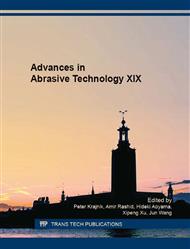p.302
p.308
p.313
p.323
p.328
p.333
p.339
p.345
p.351
Deformation Twinning of Molecular Dynamics Simulation in a Ternary Titanium Alloy under Nanoindentation
Abstract:
Nanotwinned (nt) metals exhibit excellent mechanical, electrical and thermal properties, and therefore attract much attentions. To fabricate large area nt surface, the fundamental mechanisms of deformation twinning induced by molecular dynamics (MD) are necessary to be explored. Nevertheless, MD of nt metals currently focus mainly on nt copper (Cu) and other single element metals with face-centered cubic (fcc) structure. In addition, MD simulations are usually performed on a built nt model, rather than from a single crystal, due to the difficulty of forming nanotwins. In this study, a single crystal is constructed in a ternary titanium (Ti) alloy with hexagonal closed-packed (hcp) lattice cell. Deformation twinning of MD simulation is performed in a ternary Ti alloy under nanoindentation from the built single crystal. Zonal structure is found during loading under nanoindentation, and nanograins transforms into nanotwins. Deformation twinning is significant to understanding the formation of nanotwins, as well as fabricating large area nt surface on a Ti alloy.
Info:
Periodical:
Pages:
328-332
Citation:
Online since:
October 2016
Authors:
Price:
Сopyright:
© 2016 Trans Tech Publications Ltd. All Rights Reserved
Share:
Citation:


